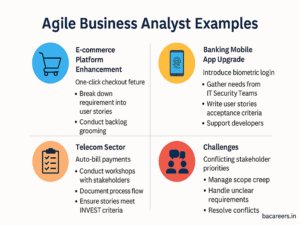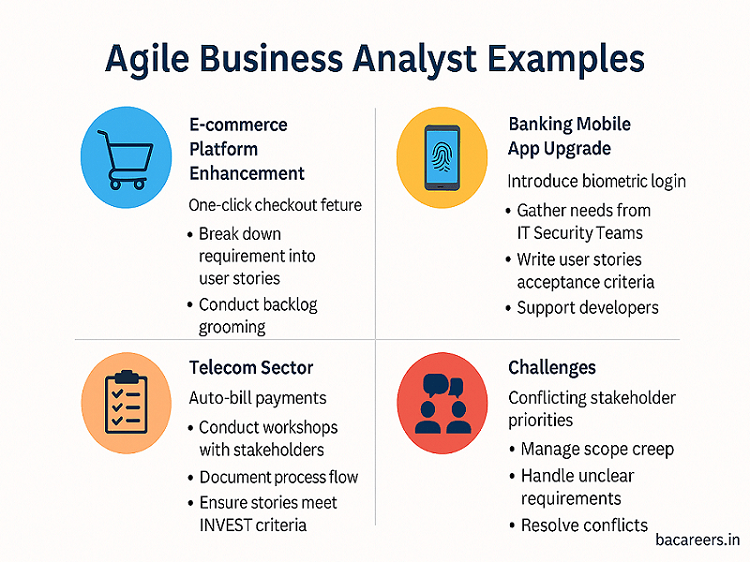Introduction: Understanding the Role of Agile Business Analyst (BA)
Let us discuss in detail about Agile Business Analyst eamples ; In Agile environments, the Business Analyst (BA) plays a flexible and collaborative role—not traditionally defined like in Waterfall projects. Agile BAs bridge the gap between stakeholders and development teams, ensuring that business needs are effectively translated into working software solutions.
✅ Fact:
The International Institute of Business Analysis (IIBA) recognizes the importance of BA in Agile via its Agile Extension to the BABOK® Guide.

1. Who is an Agile Business Analyst?
An Agile BA is a professional who works closely with Product Owners (POs), Developers, and Stakeholders to deliver business value through iterative development cycles.
Core Activities Include:
-
Refining the Product Backlog
-
Writing User Stories
-
Eliciting requirements through collaboration
-
Assisting in Sprint Planning, Daily Stand-ups, Reviews, and Retrospectives
2. Real-Time Examples of Agile Business Analyst Responsibilities
Here are real-world examples to understand the daily activities of Agile BAs:
Example 1: E-commerce Platform Enhancement
✅ Scenario:
An e-commerce company wants to introduce a new feature: One-Click Checkout.
BA Role in Agile:
-
Collaborate with PO to break down the requirement into multiple user stories (e.g., Payment Gateway Integration, Security Checks, User Session Handling)
-
Conduct backlog grooming sessions with developers
-
Clarify functionality during Daily Scrum Meetings
-
Validate acceptance criteria during Sprint Reviews
Impact:
The feature reduced cart abandonment by 25% and improved customer retention.
Example 2: Banking Mobile App Upgrade
✅ Scenario:
A bank needs to introduce biometric login (fingerprint/face recognition) to improve security.
BA Responsibilities:
-
Interact with IT Security Teams to gather compliance needs
-
Write user stories with detailed acceptance criteria
-
Use Wireframes via tools like Miro or Figma to visualize user flow
-
Support Developers during Sprint execution
Result:
90% of users adopted the new login feature within 3 months.
3. Real-Time Scenario: BA in Action (Telecom Sector)
✅ Scenario:
A telecom company wants to implement Auto-Bill Payments for postpaid users.
BA’s Actions:
-
Conduct workshops with Finance, Legal, and Technical Teams
-
Identify potential risks (auto-payment failures)
-
Document process flow in Confluence
-
Use JIRA for maintaining User Stories
-
Ensure stories meet INVEST criteria (Independent, Negotiable, Valuable, Estimable, Small, Testable)
Outcome:
Auto-pay feature rollout improved on-time payments by 40%.
4. Key Skills Demonstrated by Agile BAs in These Examples
✔ Analytical Thinking — To decompose large features
✔ Collaborative Mindset — To coordinate between multiple stakeholders
✔ Technical Awareness — Understanding APIs, integrations
✔ Adaptability — Handling changing requirements
5. Tools Used by Agile Business Analysts
| Tool | Purpose |
|---|---|
| JIRA | Manage User Stories & Sprints |
| Confluence | Maintain Documentation |
| Miro/Figma | Create Wireframes & User Journeys |
| ChatGPT | Quick ideation & drafting |
6. Internal and External Links for Further Learning
🔗 Internal Links:
🌐 External Links:
7. Best Practices for Agile Business Analysts
✔ Focus on Value Delivery: Always prioritize high-value backlog items.
✔ Collaborate Closely: Work with POs, Devs, and Testers every Sprint.
✔ Embrace Change: Be open to evolving requirements.
✔ Document Visually: Use diagrams to simplify complex processes.
8. Challenges Faced by Agile BAs (with Examples)
| Challenge | Example |
|---|---|
| Scope Creep | Marketing team keeps changing feature expectations during Sprints. |
| Conflicting Stakeholder Priorities | Sales team vs. IT Security demands in Banking projects. |
| Unclear Requirements | In Telecom projects where 3rd party vendors are involved. |
Conclusion
The Agile Business Analyst is essential in delivering successful Agile projects. From refining backlogs to supporting sprint execution, BAs ensure that business value is consistently delivered, adapting to fast-changing environments.

Business Analyst , Functional Consultant, Provide Training on Business Analysis and SDLC Methodologies.


Hello my loved one I want to say that this post is amazing great written and include almost all significant infos I would like to look extra posts like this